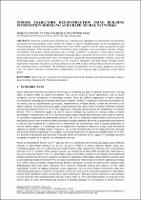Chapter Indoor Trajectory Reconstruction Using Building Information Modeling and Graph Neural Networks
Author(s)
Li, Mingkai
Wong, Peter Kok-Yiu
Huang, Cong
Cheng, Jack C. P.
Language
EnglishAbstract
Trajectory reconstruction of pedestrian is of paramount importance to understand crowd dynamics and human movement pattern, which will provide insights to improve building design, facility management and route planning. Camera-based tracking methods have been widely explored with the rapid development of deep learning techniques. When moving to indoor environment, many challenges occur, including occlusions, complex environments and limited camera placement and coverage. Therefore, we propose a novel indoor trajectory reconstruction method using building information modeling (BIM) and graph neural network (GNN). A spatial graph representation is proposed for indoor environment to capture the spatial relationships of indoor areas and monitoring points. Closed circuit television (CCTV) system is integrated with BIM model through camera registration. Pedestrian simulation is conducted based on the BIM model to simulate the pedestrian movement in the considered indoor environment. The simulation results are embedded into the spatial graph for training of GNN. The indoor trajectory reconstruction is implemented as GNN conducts edge classification on the spatial graph
Keywords
Indoor trajectory reconstruction; Graph neural network; Building information modeling; Camera-based tracking; Spatial graph; Pedestrian simulationDOI
10.36253/979-12-215-0289-3.89ISBN
9791221502893, 9791221502893Publisher
Firenze University PressPublisher website
https://www.fupress.com/Publication date and place
Florence, 2023Series
Proceedings e report, 137Classification
Virtualization


 Download
Download Web Shop
Web Shop